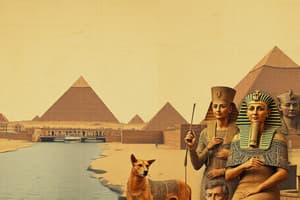Podcast
Questions and Answers
What was the primary focus of the Egyptian economy?
What was the primary focus of the Egyptian economy?
- Trade with neighboring regions
- Craftsmanship and manufacturing
- Mining of precious metals
- Agriculture dependent on the Nile (correct)
Which desert is considered a source of danger to Egypt due to predatory animals and foreign incursions?
Which desert is considered a source of danger to Egypt due to predatory animals and foreign incursions?
- Eastern Desert
- Western Desert (correct)
- Sahara Desert
- Libyan Desert
What significant change did Akhenaten introduce during the Afonian Revolution?
What significant change did Akhenaten introduce during the Afonian Revolution?
- The worship of a single god, the sun (correct)
- The expansion of trade routes
- A focus on military conquests
- The construction of pyramids
What geographical feature protected Egyptian civilization from invasions?
What geographical feature protected Egyptian civilization from invasions?
Which of the following correctly identifies the historical significance of the Nile Valley?
Which of the following correctly identifies the historical significance of the Nile Valley?
What was the relationship between the Red Sea and the Mediterranean Sea in the context of Egypt's geography?
What was the relationship between the Red Sea and the Mediterranean Sea in the context of Egypt's geography?
Which major ancient civilization began around 3000 BC and is emphasized in the study of early history alongside Egypt?
Which major ancient civilization began around 3000 BC and is emphasized in the study of early history alongside Egypt?
Which of the following aspects signifies the dual nature of Egypt regarding life and death through its deserts?
Which of the following aspects signifies the dual nature of Egypt regarding life and death through its deserts?
Flashcards
Egyptian Trip (590 BC)
Egyptian Trip (590 BC)
A voyage around Egypt, possibly along the Nile River, around 590 BC, recorded by Herodotus.
Sesostris's Canal
Sesostris's Canal
An old canal in Egypt linking the Red Sea to the Mediterranean, possibly attributed to King Sesostris.
Nile River & Valley
Nile River & Valley
The lifeblood of ancient Egypt, a fertile valley providing resources and defining the culture.
Egyptian Desert
Egyptian Desert
Signup and view all the flashcards
Eastern Desert
Eastern Desert
Signup and view all the flashcards
Western Desert
Western Desert
Signup and view all the flashcards
Egyptian Economy
Egyptian Economy
Signup and view all the flashcards
Afonian Revolution
Afonian Revolution
Signup and view all the flashcards
Mediterranean Sea
Mediterranean Sea
Signup and view all the flashcards
Red Sea
Red Sea
Signup and view all the flashcards
Levant
Levant
Signup and view all the flashcards
Ugarit/Punt/Byblos
Ugarit/Punt/Byblos
Signup and view all the flashcards
Egyptian Civilization Timeline
Egyptian Civilization Timeline
Signup and view all the flashcards
Prehistoric Egypt
Prehistoric Egypt
Signup and view all the flashcards
Mesopotamia
Mesopotamia
Signup and view all the flashcards
Study Notes
Egyptian Trip
- Egyptians travelled extensively, documented in 5000BC archival sources.
- Herodotus recorded the journey.
- The journey linked the Red Sea and the Mediterranean.
- Sesostris's Canal dated to 3000 BC facilitated this link.
Egyptian Geography
- Egypt displayed diverse topographical features.
- This geography influenced their agricultural economy.
Egyptian Economy
- Egypt's economy relied on agriculture.
- The Nile River and animals were crucial.
- Evidence found in temple walls illustrated Egyptian daily life and their reliance on agriculture.
Egyptian Civilization
- Ancient Egyptian civilization thrived along the Nile.
- Natural defensive barriers (deserts, sea) protected the civilization from external threats.
- The Nile and its delta played significant roles.
Environmental Influences
- Egypt's deserts were a significant part of their environment.
- These deserts presented dangers (animals, invaders)
- The eastern and western deserts were important features of Egyptian life.
- The deserts played a role in trade and travel routes
Time Periods
- The Egyptian civilization developed gradually over 3000 BCE-332 BCE.
- The Early Dynastic period was a formative phase.
Studying That Suits You
Use AI to generate personalized quizzes and flashcards to suit your learning preferences.




